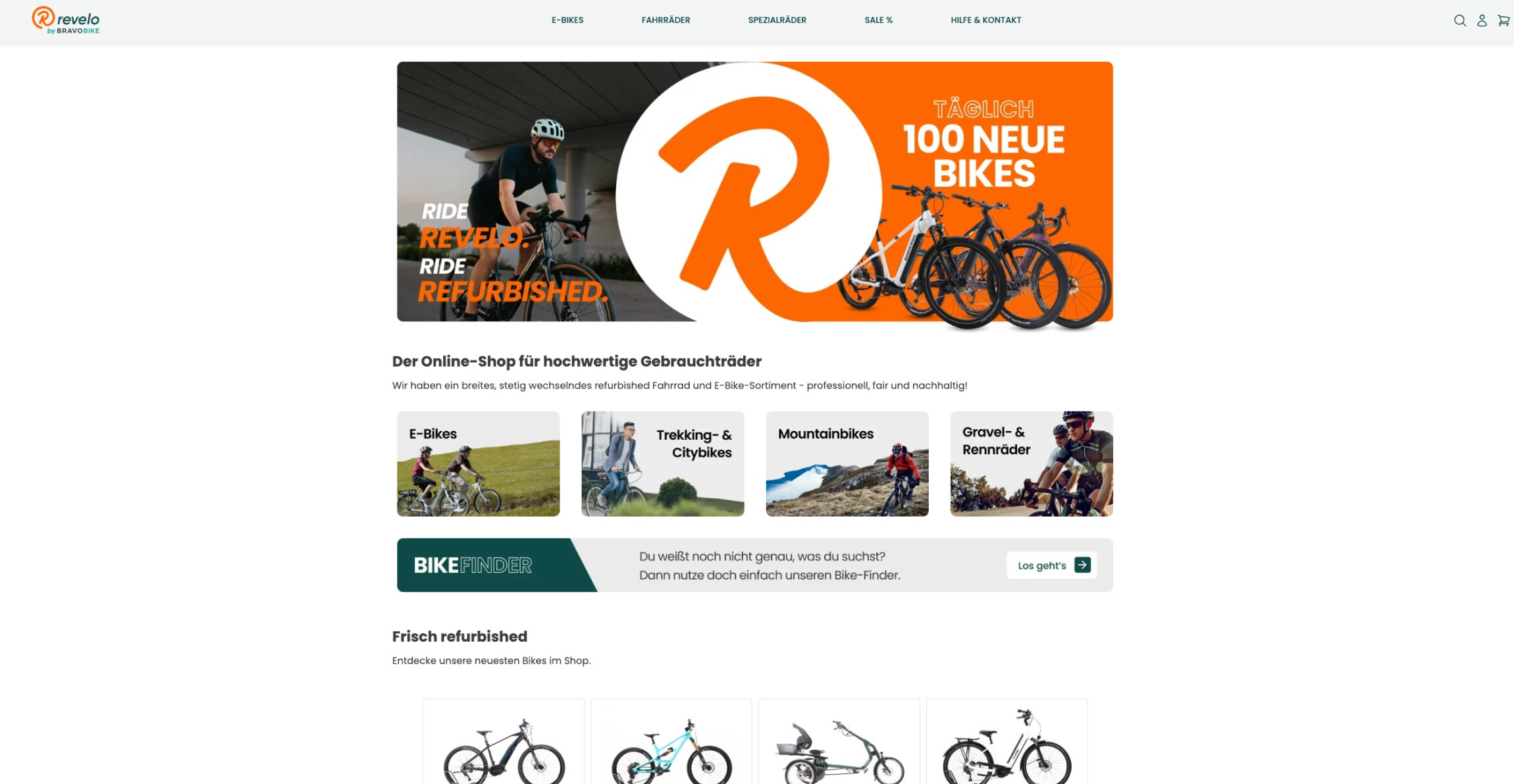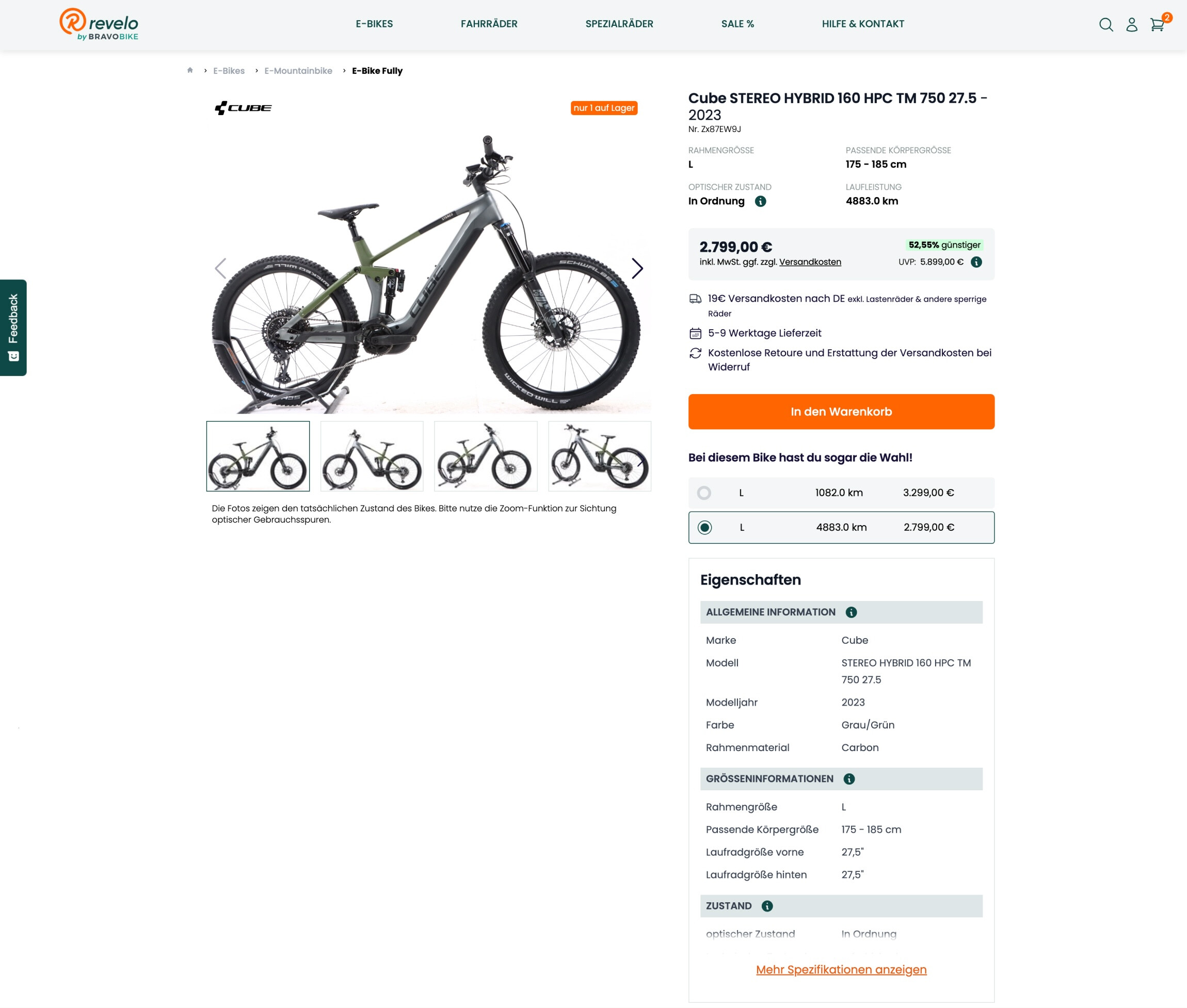
When bravobike launched in Munich, Germany, in 2018 as an online reseller of used “previously leased” bicycles, its unique business model presented multiple complexities. Unlike the used car market, there were no existing industry standards or regulations. The good news is that the demand was enormous. The company grew quickly and in 2023, its leaders realized they needed to modernize their commerce platform to support future growth. commercetools B2C Commerce and Frontend provided the perfect solution.

Axel Donath founded bravobike to offer a much-needed solution to a big problem in the bicycle industry — what to do with leased bikes after a customer’s lease (typically 3 years) expires. His vision was “to professionalize and digitize the used bike market” in an effort to drive “organic sustainability.”
With startup funding from a bike leasing company, Axel opened a warehouse to accept returns and refurbish and store the bikes until purchase. He also created the website Gebrauchtradstudio.de to resell the refurbished bikes back to consumers.
The process starts with partnering with leasing companies, who agree to hand over the contact information of customers who decline to take over bike ownership. bravobike arranges to pick up the bike free of charge. Once in possession, the process of giving it a new life begins.
When I joined the company in late 2021, eCommerce was running on a community version of the Shopware system that was unloved and only slightly configured to the businesses’ needs. At the time, the bike leasing market was experiencing a huge growth spurt. According to Statista, it quadrupled in size from 2019 to 2023 and is projected to grow to 4.5 billion EUR by 2028.
This increasing demand for bikes, fueled in part by the pandemic, led to bravobike expanding its operations from one to three warehouses. However, it was obvious that our technology was struggling to support the additional weight. There were multiple issues, just managing the logistics required to ship several hundred and then over a thousand bikes a month from one location to the other, from customer to customer, was challenging. We needed a solution that could handle these growing numbers and help relieve the pressure of having to sell these bikes quickly to customers to open up space for new ones to come in.
At the same time, we were exploring ways to extend the business model to incorporate additional products, both physical things like accessories, such as bike locks, and digital products like insurance. While I was initially brought on to find ways to make the system more scalable, the need for a new platform became abundantly clear.
Even if we lifted and shifted the stack, I knew there would still be scalability issues along with extensive cloud infrastructure costs. My goal was to find a solution that could enable us to scale and adapt quickly and give us the flexibility needed to achieve our future growth plans.
We teamed up with SHOPMACHER, an eCommerce agency that provided us with expert guidance and support. Together, we evaluated several vendors before settling on commercetools. We chose to implement both commercetools B2C Commerce and Frontend. While the flexibility of the commercetools solution was a key factor in our decision, the team also saw how its capabilities would lower our total cost of ownership and eliminate the need for additional IT resources. We didn’t want to deal with ops issues or tasks. We were able to put that out of our mind with commercetools and focus on the development itself.
To accommodate our growth plans, Axel made a decision to rebrand the eCommerce site in tandem with the switch to commercetools. Building an MVP to allow us to introduce revelo.de as a replacement for Gebrauchtradstudio.de became the first step in our digital transformation.
The scope of the MVP project was limited to the basic customer journey. We acknowledged that the site wouldn’t be “shiny and awesome” as we envisioned it to be initially and it wouldn’t have all the functionality of the former product; however, we were confident that it would provide a good foundation for us to build on.
The new revelo.de site launched in October 2023 without any promotion, and we were delighted to find that customers immediately started discovering it organically. We allowed the two shops to run in tandem for a few months, working out a few small tweaks based on feedback, before announcing the change on the original site and sending out additional signals that revelo.de was the new home of bravobike.
Once we felt confident that there were no major issues, we set a date to switch off the old shop and redirect all traffic to the new platform. There were a few synchronization issues but overall, the transition went smoothly.
We discovered in our planning that changes can be made quite easily and naturally in the commercetools environment. If a piece of software doesn’t fill our needs anymore, it’s totally fine — that’s one of the benefits of commercetools.
Senior Product Owner, eCommerce, bravobike

The combination of commercetools B2C Commerce and Frontend is empowering us to truly deliver on our mission to “professionalize and digitize the used bike market.” Not only did building the MVP bring together the different departments — marketing, sales, customer care, etc. — now since all these stakeholders understand how composable commerce works, they are offering improvement ideas that the eCommerce team can actually deliver.
Making big changes or improvements wasn’t really possible before, but now we're always talking about improvements and new features that customers can benefit from.
Senior Product Owner, eCommerce, bravobike
For me, the biggest win is that the new platform has made it easier for my team to manage the complexity of our business model. For example, our products are quite expensive, easily four digits for a used bike, so we provide a lot of details to convince the customer that we’re trustworthy and it’s a good idea to shop with us. Now, we’re able to access data along the customer journey so if we discover a piece of information is missing, we can make an adjustment without risk. We also know that different customers want different experiences, and we’re able to start experimenting with some ideas on how to segment the journey to speak directly to these target audiences.

With flexibility and scalability to support growth now in place, the future is full of possibilities. In my opinion, the whole infrastructure of commercetools is really clean. Having it as a base to build is great, especially since we’re still growing and we don’t know what’s going to happen next. This is a huge market. Currently, we only play a small role, but we’re leveraging commercetools to improve locally before, hopefully, expanding internationally.
To learn more about composable commerce and why it is the right choice for growing brands, download the white paper, Why Composable Commerce is Driving the Future of Business.